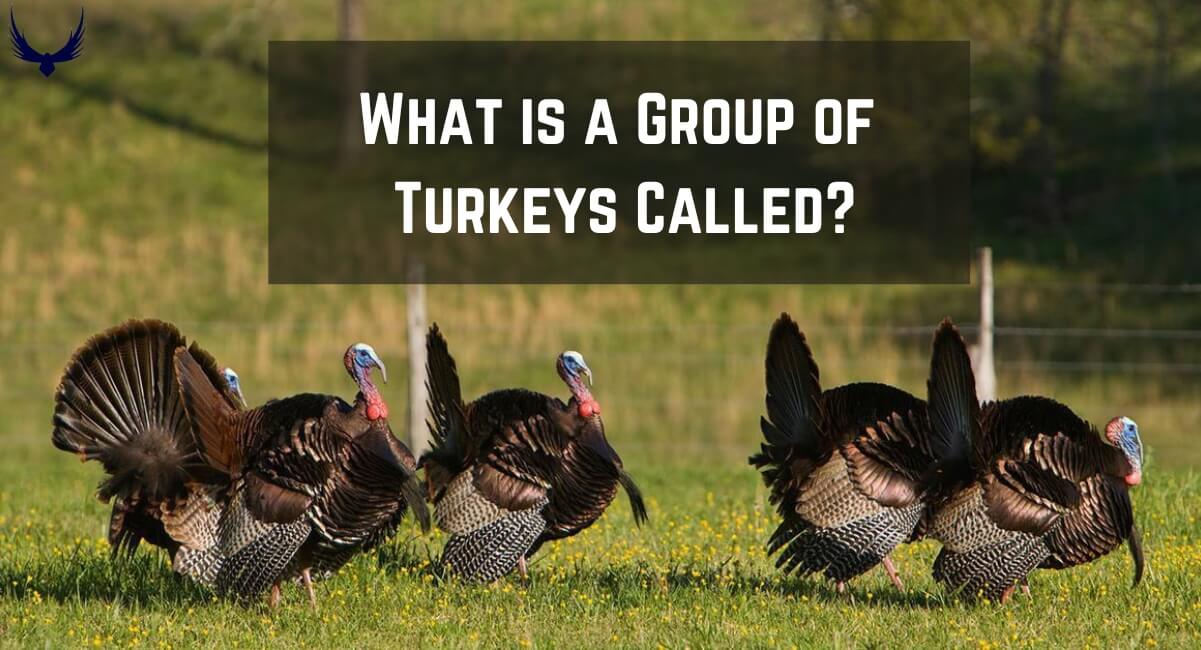Have you ever seen a group of turkeys in the woods and wondered what they are called? These birds are known for their appearance, gobbling calls, and interesting group names.
Animal groups have unique names like a murder of crows or a paddling of ducks that reflect their behavior. Turkeys also have a surprising name for their gatherings.
Let’s explore the answer to the question that What is a group of turkeys called?
What is a Group of Turkeys Called?
The most widely used general term for a group of turkeys is “Flock.” This includes both wild and domestic turkeys. A flock can range greatly in size, from just a few turkeys to over 100.
What is a Group of Domesticated Turkeys Called?
The following are the collective nouns used for groups of domesticated turkeys.
Rafters
A group of domesticated turkeys is called a Rafter. It can include both male (toms) and female (hens) turkeys. A rafter can range from a few to many turkeys. Rafters stay together and search for food as a group.
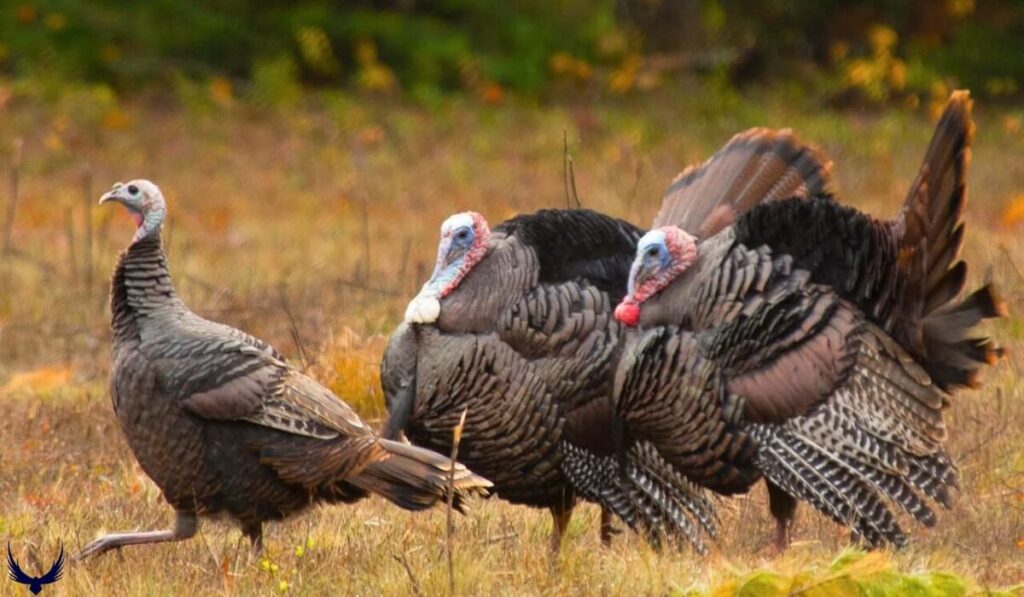
Gaggles
A gaggle refers to a group of domesticated female turkeys (hens) without any males. It’s less common than rafter. A gaggle separates from the main rafter, often with immature females, during the breeding season.
Breeding Groups
A male turkey (single tom) accompanied by a small group of females(hens) during breeding season is called a “Drav” or “Raff.” During mating season, rafters break up into smaller breeding groups
Other Terms
“Gang” is usually refers to an unruly or rowdy group of toms (males) turkeys.
“Dressing” is an obscure term that is used for a group of turkeys.
What is a Group of Wild Turkeys Called?
A group of wild turkeys is called “Flock”. This term distinguishes the social groupings of the wild turkey species from domesticated turkey breeds. A flock of wild turkeys can vary greatly in size, consisting of hens, their young (poults) from multiple breeding seasons
Male turkeys (toms or gobblers) may be alone or accompanied by a group of hens during mating season. After mating, the toms rejoin the mixed flocks of males, females, and poults. These flocks are most cohesive and largest in fall and winter when the turkeys gather to travel and forage together.
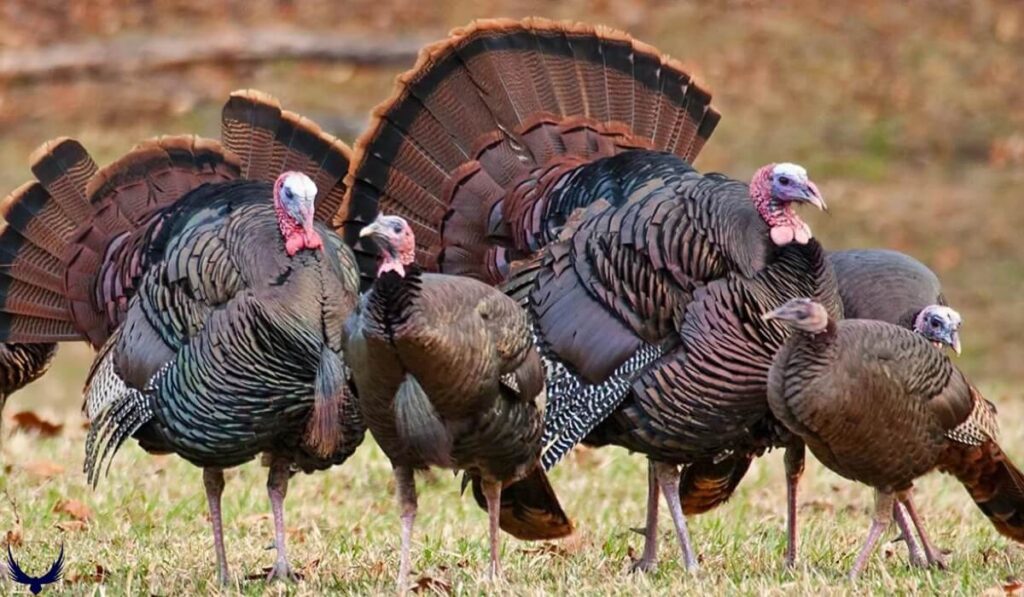
Note: In short, flock is the general term for groups of turkeys. Specific terms like rafter, gaggle, gang are used for different types of turkey groups, especially for domestic birds. But flock can be used for all group types.
Other Names for a Group of Turkeys
Here are some other names that are sometimes used to refer to a group of turkeys:
Crop
“Crop” of turkeys is an old collective noun and not used much now. It refers to the crop or pouch in their digestive system where food is stored.
Posse
Sometimes, people jokingly call a group of turkeys a “Posse” because they are like a gang of outlaws roaming together.
Death Row
Death Row is used for turkeys wait to be sacrificed for Thanksgiving and Christmas dinners.
- Run of Turkeys (wild)
- Raffle of Turkeys
- Mob of Turkeys
- Muster of Turkey
- School of Turkeys
- Dule of Turkeys
- Herd of Turkeys
- Dole of Turkeys
Why Do Turkeys Gather in Groups?
Turkeys gather and live in groups for several key reasons related to their survival and reproductive strategies:
Protection from Predators
Turkeys live in groups to watch out for predators like coyotes, foxes, bobcats, and hawks. The more turkeys in a group, the better chance they have of spotting danger early.
Turkeys work together to scare off predators using their size and numbers to stay safe. Groups of turkeys are safer than turkeys on their own, especially young chicks who are easy targets.
Better Foraging Success
Groups of turkeys work together to find and eat scattered food like seeds, nuts, berries and insects. When one turkey finds food, the whole flock can quickly converge on the area. Bigger flocks can better compete against other species for limited food resources and defend food sites.
Mate Selection
Male turkeys show off their bright feathers and behaviors to impress many females at the same time. Hens compare prospective mates’ side-by-side and select the fittest, most attractive male to breed with. The strongest males can mate with groups of hens in the flock.
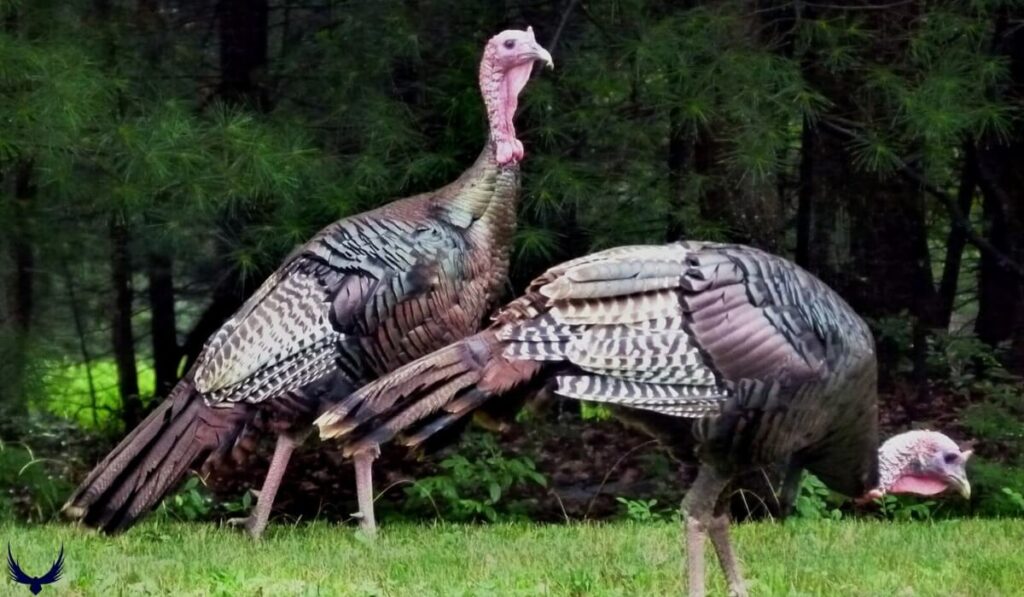
Brood Care
Hens in a flock work together to care for and protect chicks. Some hens look for food while others stay back to watch for danger and care for the young. Chicks learn survival skills by following the flock’s behaviors.
Social Facilitation
Turkeys are naturally social creatures with a strong instinct to stick together as a group. This tendency to remain in a flock serves important purposes like enabling breeding and coordinating other group behaviors.
They use sounds and cues to stay close and move as one group. It’s simply in their nature as a species to want to stay together with their feathered friends.
In short, turkeys live in groups because it helps them stay safe from predators, find food easily, reproduce successfully, take care of their young together, and interact socially.
How Many Turkeys are in a Flock?
The size of turkey flocks depends on factors like whether the turkeys are domesticated or wild, the available habitat and food sources, and if it’s the breeding season.
Small Flock
A small flock may consist of just 5 to 10 turkeys. This is common for domesticated turkeys on smaller farms.
Medium Flock
Medium sized flocks are typical and have 10 to 25 turkeys. This is a typical range for groups of wild and free-range turkeys.
Large Flock
Larger flocks may have 40 to 70 turkeys. Such big groups are more common among wild turkey populations in rural or forest areas.
Very Large Flock
In some cases, flocks of over 100 turkeys have been reported. These big flocks are rare but can happen when smaller groups merge.
What are Baby Turkeys Called?
Baby turkeys are called Poults or Turkeylings. Poult (rhymes with “bolt”) is the term use for an individual juvenile turkey. Poults are covered in downy feathers rather than adult plumage when newly hatched. Male poults are sometimes called Jakes. Brood is made up of multiple poults together.
Baby turkeys remain poults through their first few months of life until they approach adulthood.
What is a Group of Baby Turkeys Called?
When Baby turkeys are in a group, they are collectively known as “Brood” or “Rafter of poults”.
A brood refers to a group of newly hatched or very young turkeys that are still immature. It comes from the term for a hen “brooding” or taking care of her young offspring. A turkey brood consists of poults accompanied by their mother hen.

A brood of poults stays together under the mother’s guidance for several months. Once poults are fully grown and join the larger group of adult turkeys, they called a rafter or flock instead of a brood
The Social Structure of Turkey Groups
Turkeys have a complex social system. They form temporary mating groups and then come back together in mixed groups with clear hierarchies and roles. Living in groups has many advantages.
Here’s an overview of the typical social structure and dynamics within groups of turkeys:
Mating Season
During breeding season, turkeys form distinct mating groups called “harems“. Single male mates with a group of 2 to 10 females. The male turkey defends this harem group from other males.
Outside of Mating Season
Turkeys re-merge to form larger groups after mating called “rafters” or “gangs“. Rafters consist of adult males, adult females, and immature young (poults/jakes). These groups can have 10 to 100 turkeys.
Hierarchy
Turkeys establish a pecking order hierarchy in their group. The dominant tom and hen lead the group. Subordinate birds must yield resources like food to higher-ranking turkeys.
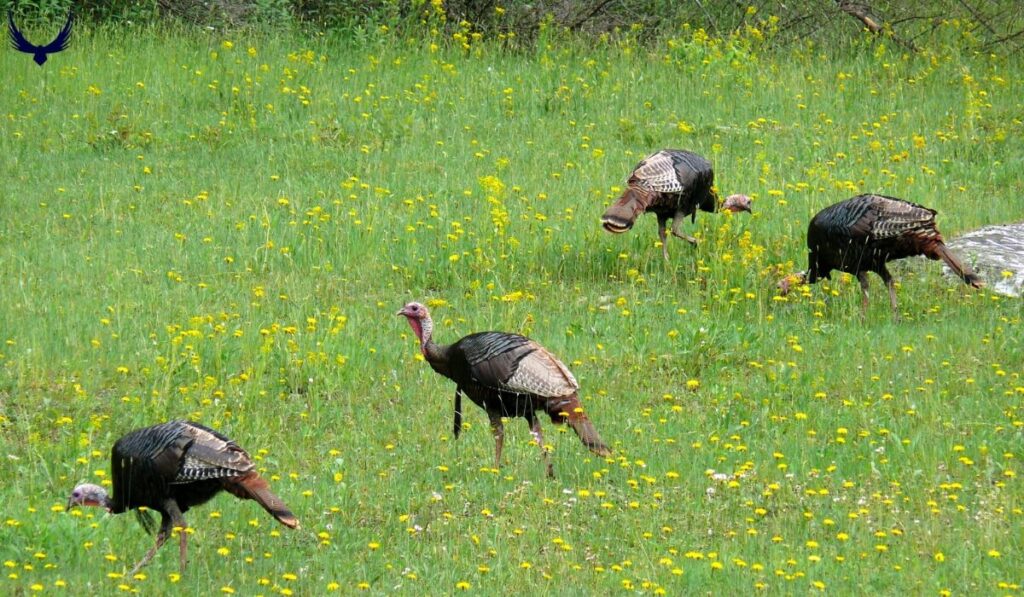
Roles
Adult males court females and defend the group territory from predators. Adult females choose nesting sites, incubate eggs, and raise poults. Immature males (jakes) stick close to adult males to learn courtship displays.
Benefits of Groups
Living in the rafters provides protection from predators. Larger groups can more effectively compete for resources like food and nesting spots. Information can spread quickly through the group about food sources and dangers.
How do Turkeys Communicate Within their group?
Turkeys communicate within their groups through a variety of vocalizations and visual displays.
Here are some of the ways by which turkeys communicate:
Vocalizations
Gobbling: The gobble sound made by male turkeys to attract mates during breeding season.
Putts or Purrs: Soft uttering sounds turkeys make to communicate with each other in a flock.
Yelps: Loud, high-pitched yelping sounds made by female turkeys gathering their flock.
Kee-kees: An alarm call turkeys make to warn others of danger.
Visual Displays
Strutting: Male turkeys puff out their feathers, spread their tails, and strut to impress hens.
Head Bobbing: Turkeys bob their heads up and down as a form of visual communication within the flock.
Wing Dragging: Males drag their wing tips on the ground as part of their courtship display.
When Do Turkeys Decide to Flock Together?
Turkeys, especially wild turkeys, tend to flock together or form larger social groups primarily for two key reasons:
Breeding Season (March to May)
Male turkeys can be alone or with a group of hens during the spring mating season. After mating, the males will rejoin the flocks. The groups then become bigger with a mix of males, females, and young turkeys from different breeding seasons.
Fall and Winter months (September to February)
As the weather gets colder and food becomes scarce, wild turkey flocks come together and get bigger. They do this to find food easier and feel safer in a larger group during winter. Flocks are usually biggest and most cohesive during this time.
Turkeys instinctively flock together for protection from predators. The size of the flock allows more eyes to watch for danger. Their good eyesight and working together make the group safer.
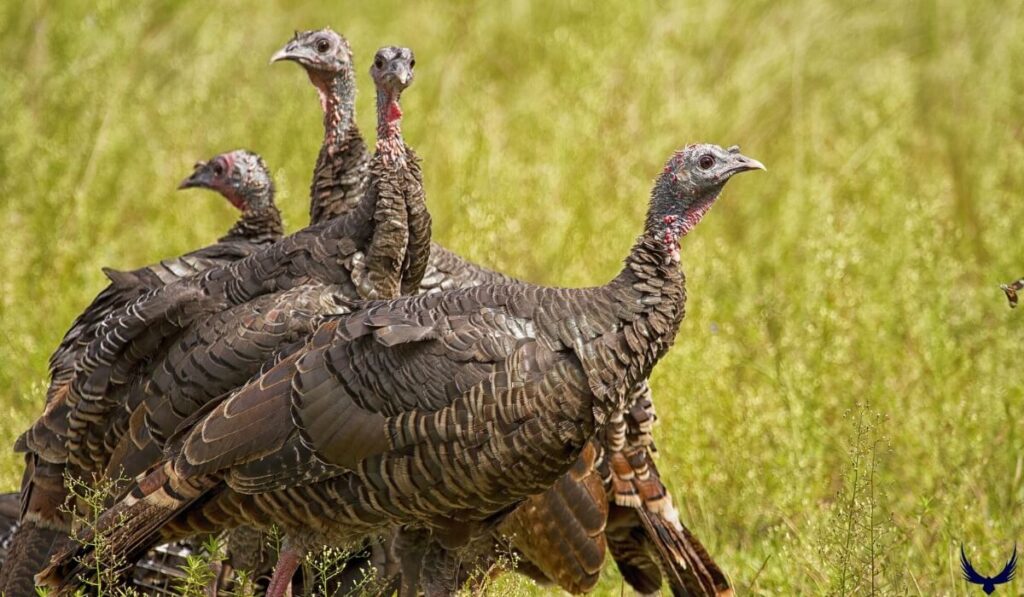
Turkeys stick together in groups to stay safe from predators. Being in a big group means more eyes can look out for danger. Their good eyesight and working together make the group safer.
Why is a Group of Turkeys Called a Rafter?
Domesticated or farm-raised turkeys gather on wooden beams called rafters in barns and coops. They like to perch high up at night to stay safe from predators. Wooden beams in barns provide a perfect spot for turkeys to roost together.
This behavior led to the term rafter to describe this group of turkeys. This term distinguishes them from wild turkeys that gather in flocks. The name rafter of turkeys comes from how these birds naturally come together in this way.
What is a Male Turkey Called?
Tom: The most common term used to refer for an adult male turkey.
Gobbler: Male turkeys are called gobblers because of the famous gobbling sound they make to attract mates during breeding season.
Jake: Young male turkey, typically under 1 year old, that hasn’t yet reached full adult size and plumage.
Strutters: When male turkeys puff out their feathers and spread their tails to strut and show off for hens, they are sometimes called strutters.
What is a Female Turkey Called?
Hen: The primary and most widely used term for an adult female turkey.
Jennies/Jenny: Hen turkeys are sometimes called “jennies” or “jenny” which is just an alternate name for a young female turkey.
Hens with Poults: When a female turkey is seen with her young offspring (poults/turkeylings), she may be referred to as a hen with poults.
Brood Hen: Female turkey that has laid eggs and is tending to a brood of baby poults is called a brood hen.
FAQs – What is a Group of Turkeys Called? 2024
Are Turkeys Always in Groups?
No, turkeys are not always in groups. Their tendency to flock together varies depending on the season and specific circumstances like breeding or nesting. During the breeding season in spring, male turkeys might be alone or with a group of female turkeys. Female turkeys nest alone and take care of their eggs and young turkeys.
Can Turkeys Fly?
Turkeys can fly short distances, up to 100 yards (91 meters) and reach heights of up to 50 feet (15 meters). Their heavy body weight limits how high and far they can fly.
What do Turkeys Eat?
Turkeys are omnivores and eat plants like grass, seeds, and berries, insects such as beetles and ants, and small animals like lizards and frogs.
How Long do Turkeys Live?
Turkeys live 3 to 5 years in the wild and up to 10 years in captivity. They are found across forests, woodlands, and grasslands of North America, with their largest populations in the eastern and southwestern United States and Mexico.

